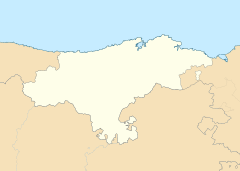Cueva del Castillo | |
 Main room | |
location in Spain | |
| Alternative name | Cave of the Castle |
|---|---|
| Location | Puente Viesgo (Cantabria), Spain |
| Coordinates | 43°17′32″N 3°57′55″W / 43.29222°N 3.96528°W |
| Type | Cave |
| Part of | Caves of Monte Castillo |
| Official name | Monte Castillo - El Castillo |
| Type | Cultural |
| Criteria | i, iii |
| Designated | 1985 (9th session) |
| Part of | Cave of Altamira and Paleolithic Cave Art of Northern Spain |
| Reference no. | 310-009 |
| Region | Europe and North America |
| Official name | Cueva del Castillo |
| Type | Non-movable |
| Criteria | Monument |
| Designated | 25 April 1924 |
| Reference no. | RI-51-0000267 |
The Cueva del Castillo, or Cave of the Castle, is an archaeological site within the complex of the Caves of Monte Castillo, in Puente Viesgo, Cantabria, Spain.

The archaeological stratigraphy has been divided into around 19 layers, depending on the source they slightly deviate from each other, however the overall sequence is consistent, beginning in the Proto-Aurignacian, and ending in the Bronze Age.[citation needed]
The El Castillo cave contains the oldest known cave painting: a large red stippled disk in the Panel de las Manos was dated to more than 40,000 years old using uranium-thorium dating in a 2012 study.[1] This is consistent with the tradition of cave painting originating in the Proto-Aurignacian, with the first arrival of anatomically modern humans in Europe.[2] A 2013 study of finger length ratios in Upper Paleolithic hand stencils found in France and Spain determined that the majority were of female hands, overturning the previous widely held belief that this art form was primarily a male activity.[3]
Cueva del Castillo was discovered in 1903 by Hermilio Alcalde del Río, a Spanish archaeologist, who was one of the pioneers in the study of the earliest cave paintings of Cantabria. The entrance to the cave was smaller in the past and has been enlarged as a result of archaeological excavations. Alcalde del Río found an extensive sequence of images executed in charcoal and red ochre on the walls and ceilings of multiple caverns.[citation needed] The paintings and numerous markings and graffiti span from the Lower Paleolithic to the Bronze Age, and even into the Middle Ages.[citation needed] There are over 150 depictions already catalogued, including those that emphasize the engravings of a few deer, complete with shadowing.[citation needed]
YouTube Encyclopedic
-
1/5Views:35 9072 3065 44261 4133 669
-
Paleolithic Cave Arts in Northern Spain(1) El Castillo Cave, Cantabria
-
Cuevas Del Monte Castillo (El Castillo) - Paleolithic Cave Art - Nov 2013
-
La Cueva de El Castillo
-
An Abandoned Blue Castle in the Jungle! El Castillo de Unibon, Morovis, Puerto Rico
-
Kukulkan - The feathered Serpent of El Castillo Pyramid, Mexico
Transcription
See also
References
- ^ Pike, A. W. G.; Hoffmann, D. L.; Garcia-Diez, M.; Pettitt, P. B.; Alcolea, J.; De Balbin, R.; Gonzalez-Sainz, C.; de las Heras, C.; Lasheras, J. A.; Montes, R.; Zilhao, J. (14 June 2012). "U-Series Dating of Paleolithic Art in 11 Caves in Spain". Science. 336 (6087): 1409–1413. doi:10.1126/science.1219957. PMID 22700921. S2CID 7807664.. "We present uranium-series disequilibrium dates of calcite deposits overlying or underlying art found in 11 caves, including the United Nations Educational, Scientific, and Cultural Organization (UNESCO) World Heritage sites of Altamira, El Castillo, and Tito Bustillo, Spain. The results demonstrate that the tradition of decorating caves extends back at least to the Early Aurignacian period, with minimum ages of 40.8 thousand years for a red disk, 37.3 thousand years for a hand stencil, and 35.6 thousand years for a claviform-like symbol. These minimum ages reveal either that cave art was a part of the cultural repertoire of the first anatomically modern humans in Europe or that perhaps Neanderthals also engaged in painting caves." The El Castillo red stippled disk (sample O-83) was dated to 41.40±0.57 ka (95% CI, corrected). Table 1: Ages are corrected for detritus by using an assumed 232Th/238U activity of 1.250±0.625 and 230Th/238U and 234U/238U at equilibrium. See also: "Spain claims top spot for world's oldest cave art : Nature News & Comment". Nature.com. Retrieved January 19, 2017.
- ^ "If the earliest cave paintings appeared in the region shortly before 40.8 ka, this would, assuming that the Proto-Aurignacian cultural complex was made exclusively by Homo sapiens, support the notion that cave art coincided with their arrival in western Europe ~41.5 ka and that the exploration and decorating of caves was part of their cultural package. However, because the 40.8-ky date for the disk is a minimum age, it cannot be ruled out that the earliest paintings were symbolic expressions of the Neanderthals, which were present in Cantabrian Spain until at least 42 ka." (Pike et al. 2012, p. 1412).
- ^ Snow, Dean R. "Sexual Dimorphism in European Upper Paleolithic Cave Art" (PDF). American Antiquity. 78 (4): 746-761. JSTOR 43184971.
External links
- Caves of Cantabria - Spanish Government Council of Culture, Tourism and Sport
- Video: Paleolithic Cave Arts in Northern Spain: El Castillo Cave



